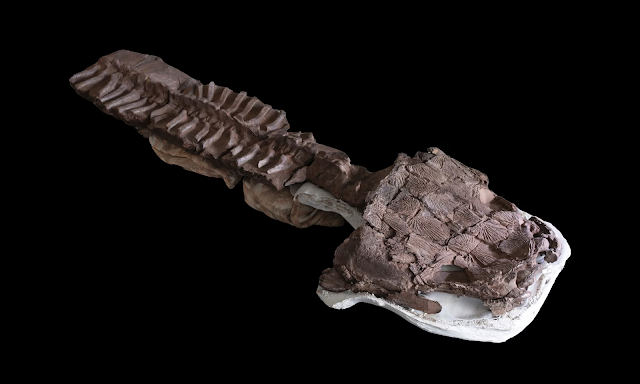Namibian fossil hunters have found a massive 280-meter-old salamander-like creature that lived before the dinosaur era and was an apex predator.
The creature, named Gaiasia jennyae, was roughly 2.5 metres long, with a head shaped like a toilet seat and menacing interlocking fangs. It lurked in lakes and chilly swamps, mouth agape, ready to snap its strong jaws shut on any unsuspecting victim that dared swim by.
Prof. Claudia Marsicano of the University of Buenos Aires, who discovered the fossil alongside colleagues, described their discovery as "really shocking" when they saw the massive specimen "just lying on the outcrop as a giant concretion." "As soon as I saw it, I realised it was something entirely different. We were all giddy with anticipation.
Gaiasia would have been one of the biggest land predators at the time and the top predator in its ecology.
Its large, flat head resembles a toilet seat, which enables it to open its mouth and take in prey. According to Jason Pardo, co-lead author of a publication reporting the fossils and employee of the Field Museum in Chicago, "It has these huge fangs, the whole front of the mouth is just giant teeth." "It's a large predator, but it may also be a somewhat sluggish ambush predator."
The fossil is named for Jenny Clack, a palaeontologist who specialises in the evolution of early tetrapods, four-limbed animals that gave rise to amphibians, reptiles, birds, and mammals, as well as the Gai-As Formation in Namibia, where it was discovered.
There have been found to be at least four partial fossil specimens, including nearly whole backbones and pieces of skulls. Gaiasia's jaw anatomy suggests that it possessed a strong bite that could take down large prey, and its skull measured roughly 60 centimetres in length.
"The front of the skull's structure caught my attention after I examined it," Marsicano added. "At that time, it was the only part that was clearly visible, and it displayed very unusually interlocking large fangs, giving early tetrapods a unique bite."
The discovery's location is noteworthy since, up until now, the majority of knowledge regarding the early development of land animals has come from fossils found at old equatorial wetlands in what is now North America and Europe. Modern-day Namibia would have been far further south, nearly level with the northernmost tip of Antarctica, and a member of the huge southern supercontinent Gondwana at the time the creature existed. Near the equator, the land was drying out and turning into forests, while closer to the poles, marshes still existed, maybe next to glaciers and ice spots.
The most recent finding demonstrates that big predators were prospering in these icy marshes despite the harsh weather. While creatures seem to have been branching out into new species in warmer, drier portions of the earth in order to become mammals, reptiles, and amphibians eventually, the fossils show stronger resemblance to more ancient vertebrates.
It indicates a significant difference between the conditions in the deep south and the equator, according to Pardo. "And that's really important because a lot of animal groups that appeared at this time have uncertain origins." As we continue to investigate, we may uncover more information about these important animal groups, such as the progenitors of contemporary reptiles and mammals.
Published in Nature is the research findings.
Source theguardian.com





Comments
Post a Comment